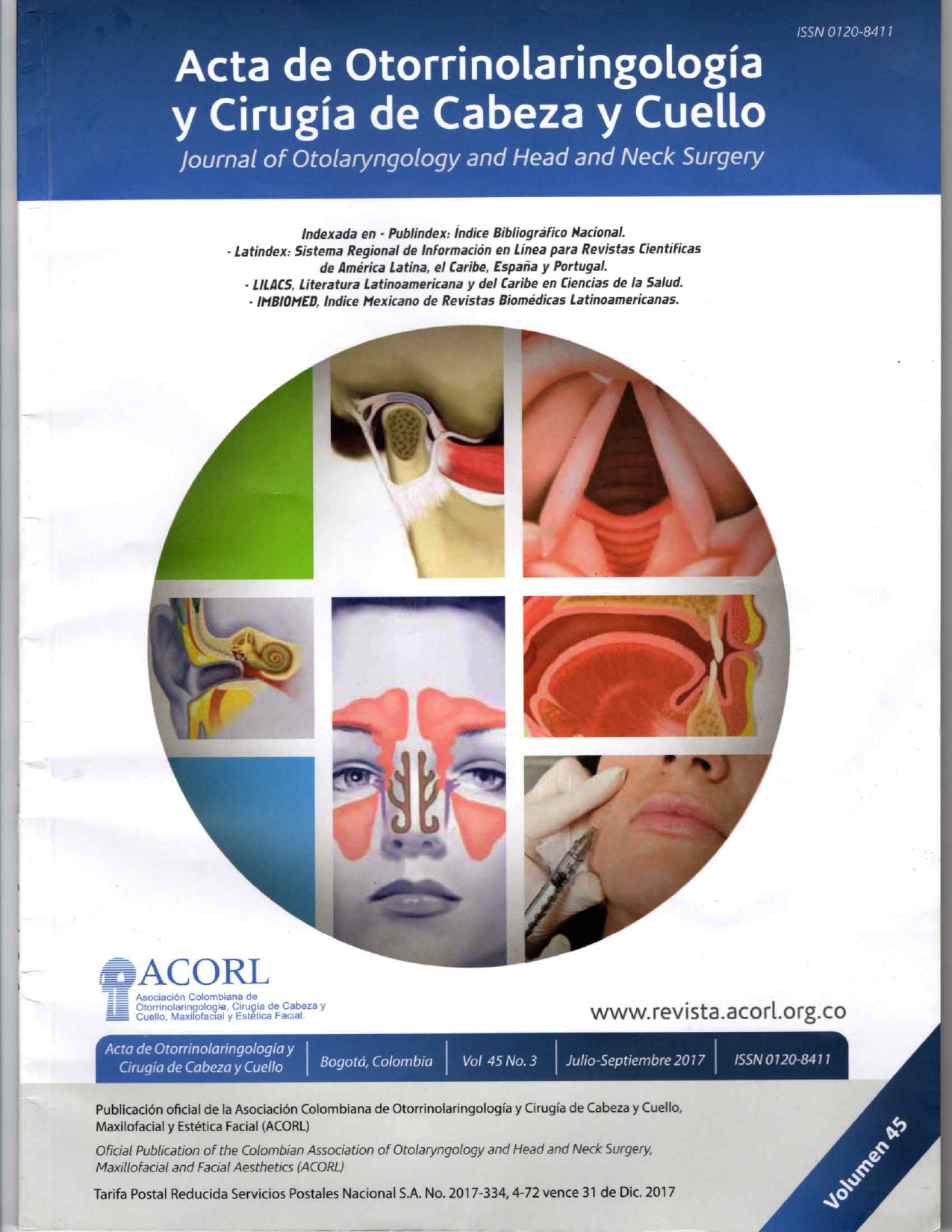Septorrinoplastia y su influencia en el acondicionamiento nasa
Contenido principal del artículo
Resumen
Materiales y métodos: Se incluyeron 42 pacientes este estudio, se midieron la temperatura y humedad del ambiente y la intranasal del paciente, además del grado de obstrucción nasal antes y doce meses después de la cirugía; se utilizó una escala subjetiva de obstrucción nasal y un termohigrómetro con sensor externo para las mediciones intranasales.
Resultados: Los valores de temperatura, humedad postoperatorias y la escala subjetiva de obstrucción nasal fueron de manera significativa estadísticamente mayores en comparación con las preoperatorias (p<0,05).
Conclusiones: De acuerdo con los resultados de este estudio, los pacientes tienen un beneficio general gracias a una mejoría del acondicionamiento del aire nasal inspirado posterior a la realización de una septorrinoplastia funcional y estética primaria.
Detalles del artículo
Sección

Esta obra está bajo una licencia internacional Creative Commons Atribución-CompartirIgual 4.0.
Este artículo es publicado por la Revista Acta de Otorrinolaringología & Cirugía de Cabeza y Cuello.
Este es un artículo de acceso abierto, distribuido bajo los términos de la LicenciaCreativeCommons Atribución-CompartirIgual 4.0 Internacional.( http://creativecommons.org/licenses/by-sa/4.0/), que permite el uso no comercial, distribución y reproducción en cualquier medio, siempre que la obra original sea debidamente citada.
eISSN: 2539-0856
ISSN: 0120-8411
Cómo citar
Referencias
Tsakiropoulou E, Konstantakos V, Leiacker R, Rettinger G, Lindemann J. Temperature and humidity measurements in nasal cavity. MeMeA. 2009; 69-72. doi: 10.1109/ MEMEA.2009.5167957
Seakins PJ. Measuring temperature and humidity in the breathing circuit. Respir Care Clin N Am. 1998; 4(2):229–42.
Rozsasi A, Leiacker R, Kühnemann S, Lindemann J, Kappe T, Rettinger G, et al. The impact of septorhinoplasty and anterior turbinoplasty on nasal conditioning. Am J Rhinol. 2007; 21(3):302-6.
Jackson LE, Koch RJ. Controversies in the management of inferior turbinate hypertrophy: A comprehensive review. Plast Reconstr Surg. 1999; 103(1):300-12.
Jang YJ, Myong NH, Park KH, Koo TW, Kim HG. Mucociliary transport and histologic characteristics of the mucosa of deviated nasal. Arch Otolaryngol Head Neck Surg. 2002; 128(4):421-4.
Pless D, Keck T, Wiesmiller K, Rettinger G, Aschoff AJ, Fleiter TR, et al. Numerical simulation of air temperature and airflow patterns in the human nose during expiration. Clin Otolaryngol Allied Sci. 2004; 29(6):642-7.
Lindemann J, Leiacker R, Sikora T, Rettinger G, Keck T. Impact of unilateral sinus surgery with resection of the turbinates by means of midfacial degloving on nasal air conditioning. Laryngoscope. 2002; 112(11):2062-6.
Lindemann J, Keck T, Wiesmiller K, Sander B, Brambs HJ, Rettinger G, et al. A numerical simulation of intranasal air temperature during inspiration. Laryngoscope. 2004; 114(6):1037-41.
Grymer LF, Hilberg O, Elbrond O, Pedersen OF. Acoustic rhinometry: evaluation of the nasal cavity with septal deviations, before and after septoplasty. Laryngoscope. 1989; 99:1180–7.
Kimmelman CP. The risk to olfaction from nasal surgery. Laryngoscope. 1994; 104(8): 981-8.
Bohlin L, Dahlqvist A. Nasal airway resistance and complications following functional septoplasty: a ten-year follow-up study. Rhinology. 1994; 32(4):195-7.
Uslu H, Uslu C, Varoglu E, Demirci M, Seven B. Effects of septoplasty and septal deviation on nasal mucociliary clearance. Int J Clinical Pract. 2004; 58(12):1108-11.
Lindemann J LR, Stehmer V, Rettinger G, Keck T. Intranasal temperature and humidity profile in patients with nasal septal perforation before and after surgical closure. Clin Otolaryngol Allied Sci. 2001; 26:433–7.
Keck T, Leiacker R, Kühnemann S, Rettinger G. Heating of air in the nasal airways in patients with chronic sinus disease before and after sinus surgery. Clin Otolaryngol Allied Sci. 2001; 26:53–8.
Kastl KG, Rettinger G, Keck T. The impact of nasal surgery on air-conditioning of the nasal airways. Rhinology. 2009; 47(3):237-41.
Lindemann J, Keck T, Leiacker R, Dzida R, Wiesmiller K. Early influence of bilateral turbinoplasty combined with septoplasty on intranasal air conditioning. Am J Rhinol. 2008; 22(5):542-5.
Papp J, Leiacker R, Keck T, Rozsasi A, Kappe T. Nasal-Air Conditioning in Patients With Chronic Rhinosinusitis and Nasal Polyposis. Arch Otolaryngol Head Neck Surg. 2008; 134(9):931-5.
Assanasen P, Baroody FM, Abbott DJ, Naureckas E, Solway J, Naclerio RM. Natural and induced allergic responses increase the ability of the nose to warm and humidify air. J Allergy Clin Immunol. 2000; 106(6):1045-52.





